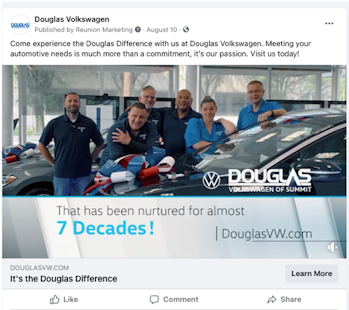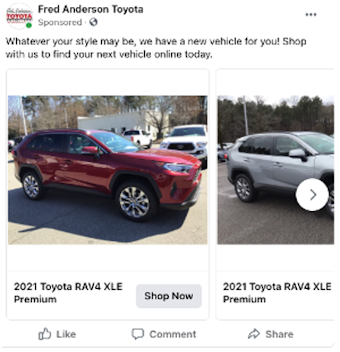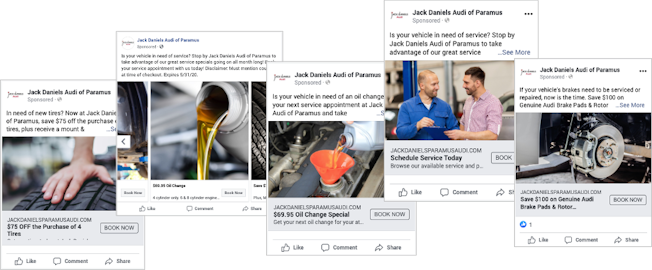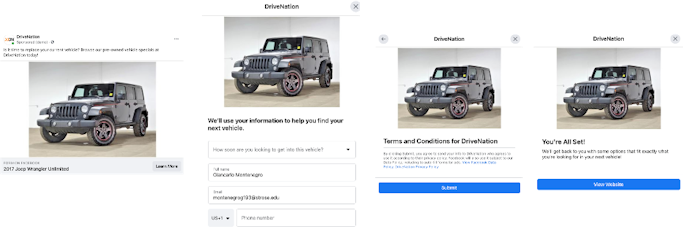Embracing the Future Facebook Ecosystem of Today

The title may have seemed confusing. If we’re going to take a dive into a future ecosystem, how can it also be available today? The answer is simple: adoption rate. The capabilities outlined in this article are available right now; however, many dealers are not embracing them and continue to advertise on Facebook as they always have.
You have an opportunity to do today what all of your competitors will — or at least should — be doing in the future.
Here’s what we’ve been so accustomed to do …
- Create a carousel ad.
- Send the consumer to the website.
- Retarget those who don’t engage.
The second step is problematic. It’s important that we break the cycle of thinking that all traffic must go to the website. With a 3-5% opt-in rate of Apple users deciding to share their data with Facebook and its applications and losing 85% of website-based conversion data because of this and other privacy constraints, continuing to advertise on Facebook as we always have is already outdated thinking.
Facebook has products that allow advertisers to embrace a completely native ecosystem.
Here’s a question: If a consumer is choosing to be on Facebook, why would we remove them from that place of comfort and take them to a website?
Here’s a second question: Isn’t our role as advertisers to meet where consumers want to engage with us and offer a seamless experience?
So here’s how we do that.
A Breakdown of the On-Facebook Ecosystem
Branding — Top-of-the-Funnel
Let’s first caveat this part of the ecosystem. Branding lives outside of the 30-day cycle, and you don’t want to hold these ads accountable to metrics beyond reach, impressions, and frequency. While these will create clicks and drive traffic to your online properties — mostly your website — these ads are intended to keep your dealership top-of-mind as consumers who aren’t quite in-market spend their time on the Facebook platform and its network partners.
Your branding ads should communicate your differentiators, value propositions, and culture. They should also communicate facets of your business that are evergreen, such as your ability to purchase consumer cars or the loyalty programs and free estimates that your fixed operations may offer.
Such as with Douglas Volkswagen, who’s inviting local potential shoppers to come experience the “Douglas Difference,” which has been nurtured for nearly 70 years.
Or you may want the local community to know that you’ll buy their vehicle — whether or not they bought one from your dealership.
Regardless of the ad’s message, you want to make sure that the page they land on when they click the call-to-action — in these cases, “Learn More” — is directly aligned with the content of the advertisement.
AIAs and Service Ads — Middle-of-the-Funnel
As you continually hold a presence with branding ads, you’ll want to capture those local shoppers who are in-market.
Side Note — We recommend that you don’t rely solely on Facebook targeting as you can add layers of depth and precision to this with a partner like IHS/Polk, who can provide an accurate number of households based on parameters you set — and this data isn’t affected by privacy updates or website data-loss as it’s based on actual sales and credit reporting data, not on online signals like pixels.
The ability to create hyper-local, highly targeted audiences will make creating ad sets and ad copy easier as you’ll have a clear understanding to whom you’re delivering those ads.
Automotive Inventory Ads (AIAs) are a carousel of vehicles that are relevant to the targeted audience, except these offer advertisers the capability to keep consumers on Facebook for a streamlined experience.
The carousel ad gets delivered to the audience to browse the relevant vehicles that are available for purchase at your dealership.
When they click a vehicle that interests them, a VDP-like page near instantaneously appears. It has all of the information that your traditional VDP contains, it has deep links to your dealership’s website and onsite VDP for dealers who need a little comfort in making this transition — and most importantly, it has different actions to actually capture a lead, including click-to-call, directions request, and chat.
This method keeps consumers within the Facebook ecosystem, so we don’t lose any conversion data. Facebook collects the information on how consumers are behaving, what different attributes and facets of the VDP are most effective, and other pieces that can better inform them and us on what works. The more data that we can feed Facebook, the more accurately they can update this content and assist us as advertisers to make more strategic decisions.
Here are the results when we looked at all campaigns that took consumers to the dealership website (non-AIA) compared to campaigns that kept consumers on Facebook (AIA).
Significantly more content viewed, significantly lower costs, and significantly more actual leads from Facebook — people chatting, calling, and requesting directions from the on-Facebook VDPs. 
I wrote that this is also applicable to service. It’s true: we currently use IHS/Polk ownership data to layer onto native Facebook targeting to create a more accurate picture of the audiences to whom our ads will be the most relevant, breaking these ads out into the big four — brakes, batteries, tires, oil changes — and general service ads.
At this moment, we do not have the mechanisms in place to keep consumers on Facebook and embrace the new ecosystem; however, our Social Media Director wanted to be deliberate in getting the sales portion fine-tuned before diving into fixed operations. What I can say at this moment is that there are more sophisticated schedulers that can integrate with your dealership’s internal systems to create the same experience in service as we have in sales.
Now not every customer in-market or near-market will become an immediate lead. Just like as with website visitors in the past, the consumers who click on one of your ads will be placed into a retargeting pool. This is where our strategic approach to the Facebook ecosystem has evolved the most.
Retargeting Lead Generation Ads — Bottom-of-the-Funnel
This is where I may lose you because you’ve done lead generation ads before on Facebook. I’m going to challenge that pushback. The approach is where we, as advertisers, went wrong in leveraging lead generation objectives on Facebook. We cast a wide net and hit people with ads who had potentially never engaged with any of our content — and we expected them to simply opt in to sharing their information.
That’s unproductive. It yields spammy leads. It wastes your time and your budget.
It was a shiny “instant lead retrieval” object that had foregone deliberate strategy.
The correct philosophy is to understand that consumers who have demonstrated intent and interest in our inventory and services — with our middle-of-funnel ads — are more likely to see a lead generation ad as relevant to their interests and, thus, is much more likely to be a qualified lead.
So using lead generation as your measured and deliberate retargeting campaign will work in your favor because the element of intent or interest is at play. They’ve clicked through one of your middle-of-funnel ads and browsed the VDP but didn’t contact the dealership via Messenger within the last 30 days.
That, however, isn’t the only parameter (intent/interest) that makes an effective lead generation retargeting campaign.
It’s also important to still task the consumer to take an action without putting an undue burden on them. We want to pose a question that gauges the urgency of their purchase intent. So when the consumer has engaged the lead generation ad, their name and email is automatically populated — but to ensure that a click isn’t merely accidental, the consumer has to actively select an option from a dropdown menu.
When they have done that and done any necessary changes to email, name, or even add their phone number, they are opted into terms and conditions that they have to accept, and then are given a notification that they will be contacted — that information all gets routed to your CRM so that you can track it from form submission to the sale of the vehicle. Our team uses LeadsBridge for this capability.
So you’ve ensured that the consumer has chosen to engage with the lead generation ad and has taken actual actions to share their information, which demonstrates several layers of intent.
It’s all a matter of keeping things simple and structured.
When our team put this into a beta test, it generated an average of 83 qualified leads per month at a cost of around $8 per lead.
The On-Facebook Ecosystem
Facebook has adapted in the face of privacy constraints and the eventual deprecation of the third-party cookie. It’s important that we embrace the future Facebook ecosystem of today because this is the environment in which we will all compete. By understanding how consumers want to engage with us, as well as the fact that platforms like Facebook and Google are creating ecosystems that keep consumers within their own properties, we will be better equipped to produce content that better resonates with them.
If you have any further questions regarding this evolution or the different tactics presented in this article, please feel free to reach out to me, Dane Saville, at dane@reunionmarketing.com.

authored by
Dane Saville
Dane Saville has enjoyed an eclectic career from the classroom to the classified room for the Department of Navy to the studio. One thing has remained constant among all of the changes: educational distillation. \nHe helped co-found Reunion Marketing as its thought leader on content marketing and has spent the last few years learning from experts in all disciplines of digital marketing to pull out the essential pieces for easy-to-learn content. Dane now hosts an educational automotive podcast series, the KPI Cafe, available on all major podcast platforms.
Get Curated Insights
Content worth the click


